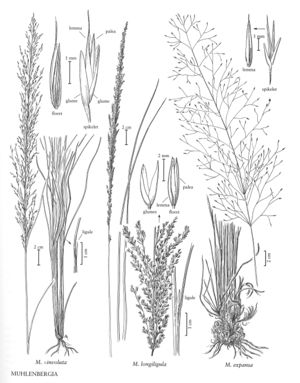Difference between revisions of "Muhlenbergia ×involuta"
FNA>Volume Importer |
imported>Volume Importer |
||
| (3 intermediate revisions by 2 users not shown) | |||
| Line 39: | Line 39: | ||
|publication year= | |publication year= | ||
|special status= | |special status= | ||
| − | |source xml=https:// | + | |source xml=https://bitbucket.org/aafc-mbb/fna-data-curation/src/200273ad09963decb8fc72550212de541d86569d/coarse_grained_fna_xml/V25/V25_764.xml |
|subfamily=Poaceae subfam. Chloridoideae | |subfamily=Poaceae subfam. Chloridoideae | ||
|tribe=Poaceae tribe Cynodonteae | |tribe=Poaceae tribe Cynodonteae | ||
Latest revision as of 17:58, 11 May 2021
Plants perennial; cespitose, not rhizomatous. Culms 60-140 cm, erect; internodes puberulent or glabrous for most of their length, puberulent below the nodes. Sheaths shorter or longer than the internodes, smooth or scabridulous, tightly imbricate, yellowish-brown, basal sheaths laterally compressed, keeled, not becoming spirally coiled when old; ligules 3-12 mm, firm and brown basally, membranous distally, acute; blades 10-45 cm long, 1.6-5 mm wide, tightly folded, scabrous abaxially, hirsute adaxially. Panicles 18-40 cm long, 1.5-7 cm wide, loosely contracted to open, not dense; branches 1-10 cm, ascending or diverging up to 60° from the rachises, stiff, naked basally; pedicels 2-8 mm, hirtellous. Spikelets 3-4.2 mm, yellowish to purplish. Glumes subequal, 2-3 mm, exceeded by the florets, scabridulous or smooth, 1-veined, acute or obtuse, unawned; lemmas 3-4.2 mm, lanceolate, glabrous or appressed-pubescent on the lower 1/4 of the margins, apices acute to obtuse, usually bifid and awned, teeth to 0.3 mm, awns 0.5-4 mm, straight; paleas 3-4.2 mm, lanceolate, glabrous, acute to acuminate; anthers 1-1.8 mm, purplish. Caryopses not seen. 2n = 24.
Discussion
Muhlenbergia ×involuta grows on rocky, calcareous slopes in openings and along canyons, at elevations of 150-500 m. It has only been found growing naturally in Texas, but it is also available commercially as an ornamental. Swallen (1932) suggested that M. reverchonii and M. lindheimeri were its parents, but M. rigida seems to be another plausible possibility.
Selected References
None.
